a blog about my personal worldbuilding project. posting random notes, art and other shit. wiki@rajavlitra - main
Don't wanna be here? Send us removal request.
Photo
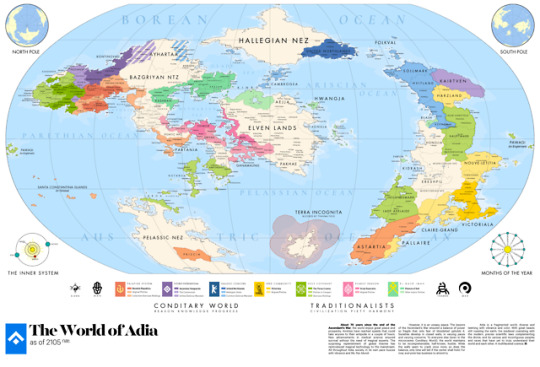
A full political world map of Adia.
10 notes
·
View notes
Photo
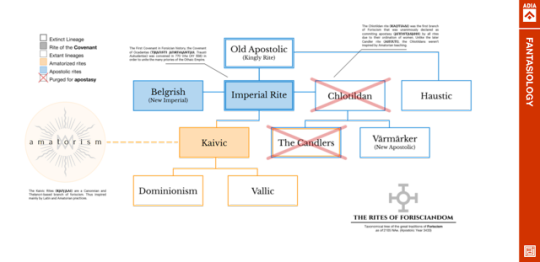
religion notes | Foriscian rites
A rite (𐍄𐌰𐌹𐌻𐌰𐍃𐍄, tälast) is a broad term within the Foriscian faith, the dominant religion in western Antrecia. It comprises of traditions, creeds and rituals that make up a unified interpretation of Foriscian thought. The lack of real consensus between the Presbyters and the Kings after the fall of the Othaic Empire (~830 v. — 340 n.) ensured the current diversity of such rites in the West, making it a common point of contrast to the secular politics of the region by Conditary sociologists, defining the Antrecian subcontinent wedged between the firm unity of the Amatorian churches and the semi-coherent manifoldness defined by the loose Covenants of their Foriscian counterparts. Despite their division, the Foriscians united do not take deviation from the faith lightly, and has been known to have suppressed and (quite brutally) eradicated "Apostates" (what Foriscians call their heretics) in order to herald the return/coming of Tevas' holy authority. This fury of faith has not changed even today, as the Presbyters of the Belgrish and (corrected) Värmärker covenants calling (even at the exasperation of the monarchs they crowned) for the utter destruction of the Amatorian-flavored Kaivic rite of the Elves, which they call "the most pungently noxious insult to the Hosts of heaven".
<small>some notes that didn’t make it in the final cut: the Värmärker rite, while not necessarily directly descended from the apostate Chlotildan rite, their practices derive from them on the basis that the Chlotildans were actually practicing the ancient rituals of the Apostolic era. They managed to survive the Imperial pogroms with their renouncement of the Chlotildan clergy.</small>
2 notes
·
View notes
Photo
culture notes | Daya no Carangan
The Ladies of the Bladesong (Pala. Daya no Carangan) is an ancient lineage of warriors originating in Min. Primarily known for their religious significance and martial skill, they were also the first masters of the ancient thaumic arts of Sword-music and Sunbeaming, both of which are now regarded as a fundamental aspect of martial thaumaturgy throughout the Bridgelands. Originally founded in 300 va. as an elite temple guard to defend and uphold Dharma among the Temples of Serabayu, daughter of the Lion and Elucidator of Warmth, today it is a scholarly lineage that maintains its original purpose. Unlike other thaumaturgic lineages, there can only be one Lady of the Bladesong at any given moment in time, a mantle passed on individually master to student. The invasion of the Aashi Yunggan in 1402 would later diminish the power of the Daya to its current form.
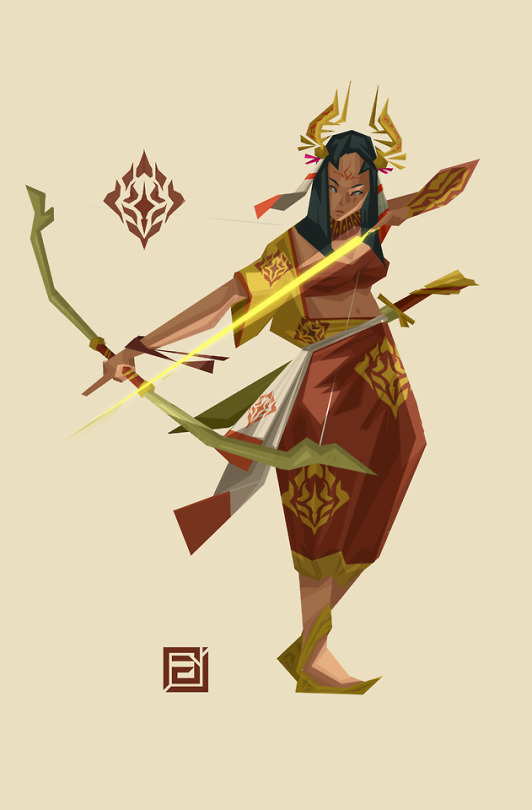
26 notes
·
View notes
Photo
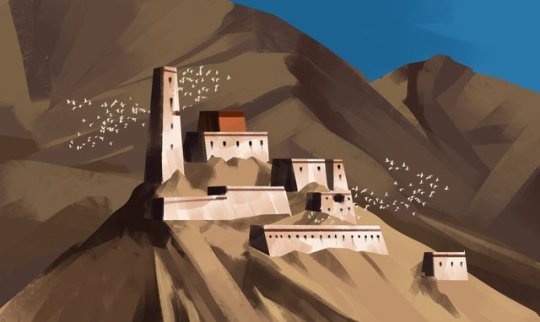
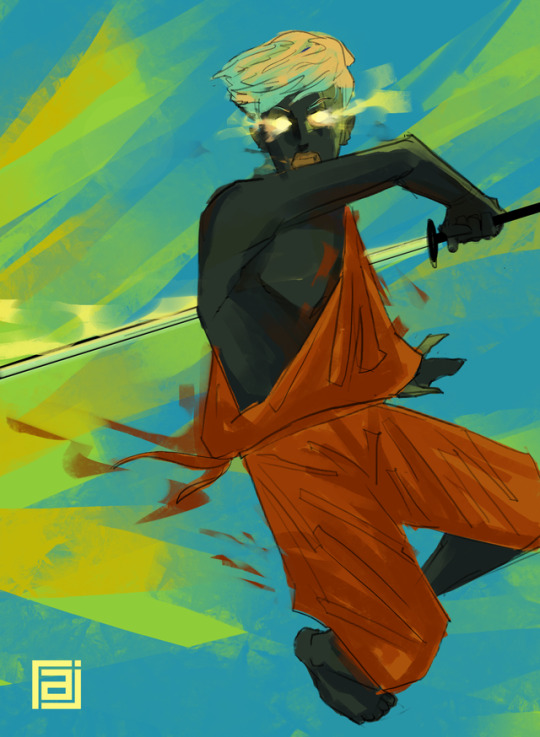
society notes | Bagavarti
The ancient peoples of Bagavart are known for three things: 1) their famously dark complexion and 2) their particular form of rudimentary thaumaturgy, called the kishi rahangi, and 3) their peculiar but not unexpected social organization. Living in enclosed networks of communities independent on one another (a prakrtantra), the Bhagavarda live a solitary existence, interacting sparsely with the outside world and deeply hostile to unobservant trespassers.
It wasn’t until 1956nae; that a larger window to their socierty was opened with the anthropological expedition of the Wondrous Twelve, thaumatological scientiests devoted to unlocking the secrets of the prehistoric Hyratian world-system. In it revealed a new insight towards the civilizations of the Bridgelands and the Orient.
The Bhagavarda are a deeply religious people, defined by pyrophilic tendencies informed by their religion of Madradaha, which reverse the god Jvalavanara, the Burning Monkey and Vanquisher of Ten Thousand Kings. Fire plays a deep role to the reclusive society, being a central focus among their rites of passage and living sacraments. Youth must pass through a pyre or a path of burning coals before their initiation to adulthood, marriage was made binding through the merging of the bride and groom’s candlefires, and their ubiquitous cremation rituals require different colors of flame depending on the aptitude of their Dharma and their social status.
Dharma defines almost all social relations among the Bhagavarda. Meaning “correctness” and “order”, Dharma in the Bhagavard context is a person’s orderliness and adherence towards the rites, a social capital focused on the maintenance of socio-ritual equilibrium. A person who participates the most and most observant of correct conduct is considered of Mahadharma, ones worthy of great reverence and worthy to rule. The opposite (Nyunadharma) are considered anathema to thesocial order and thus ostracized or banished (the worst case apparently is live cremation, a practice passed on to the Essians whom they historically traded with).
The collective polities within the northern Bridgelands (referred to in modern diplomatic language as the “Bhagavard Kingdoms” have been recently opening up to the wider world, and their recent cultural exports the past 5 decades have been the key for the Conditary World’s good reception of northern Bridgelander culture. The Bhagavard diaspora as of 2105nae; number towards 5 million.
1 note
·
View note
Photo
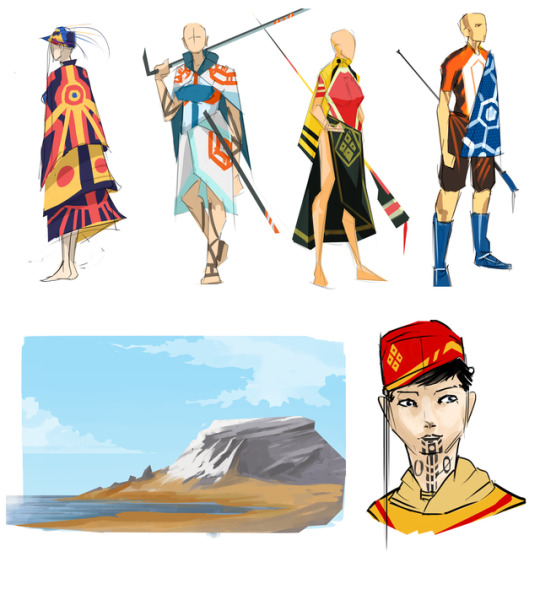
sketches for the hallegians and their homeland. Fuck, i didn’t realize how goofy they look until i was done.
4 notes
·
View notes
Photo

magic notes | Hrdayan thaumaturgy
The Hrdaya (”heart” or “mind” in the Bagang language) school of Divination is an early proponent of contemporary thaumatology. A Partanian institution, Hrdayan thaumaturgy has become one of the elite schools of Bridgelander magic, renowned for their particular cadence, utilization of fighting skill and precise movement as part of their esoteric formulae.
The Hrdayan school is primarily defined by its synthesis of western principles and Essian practice, most being based on the esoterica and cosmological study of the Amatorians (by way of the syncretic Florentine church) and the cosmology and traditions of the native Mayangtali religion.
To the practitioners of Hrdaya, thaumic energy (kalulu’a or betud) actively passes and circulates throughout the earth (rocks, soil, mountains), one that a thaumaturge can conduct through an earth-based material, such as wood or metal (thus making the cane or sword the preferred wand of order). This power circulates rapidly, and thus the Pantas ( f. Ambas)--the Hrdayan divinator--must execute magical formulae quickly and loosely, using both movement (through fighting and esoteric gestures) and incantation to exert an immediate but strong force. Such energies can also be conducted as a shield against opponents through talismans made of gold.
Behavior, code of dress and comportment are important to the Pantas. Presenting themselves as upright and refined intellectuals in the western sense while staying true to the Mayangtali faith, a Pantas or Ambas is required to maintain in such a state of properness, formality and fastidiousness, both to maintain their thaumaturgical proficiency and instill a sense of honor among them.
3 notes
·
View notes
Text
It is a time most barbarous when men anointed by priests are sovereign over the syndics of law.
Livia Salvatrina, 466 VÆ.
0 notes
Photo
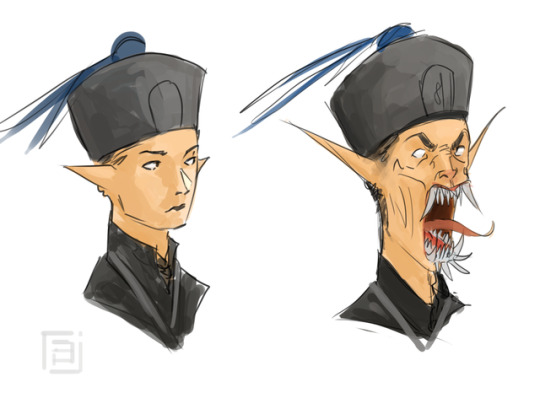
society notes | The Elves
The Elves (endonym Xiangkhur) are an ancient hominid race whose traditional range is within much of the Essian continent, primarily the northern Essian Steppe. Masters of thaumaturgy, known history considers the Elves as the original magicians, splitting off from mainstream Humanity with their discovery and later affinity towards Thaumic energies, something the Elves have acknowledged and taken pride of.
An open secret in regards to the full extents of their divergence from the main Human line is their ability to enter in a “demon-state” (vairakhta). Under the vairakhta, an elf transforms into a grotesque carnivorous creature, with immense strength and amplified animalistic qualities. They are also most vulnerable within such states, they will have great sensitivity to sodium chloride and sunlight.
The relations between Elves and other races are quite spotty and only until much recently have been fruitful. Preferring their own kind, the Elves are a deeply familial people, valuing their clan greatly and deeply protective of their kin, sometimes to the point of extreme violence. However, more progressive Elven clans (calling thermselves the Khungna) have initiated open dialogue with the Conditary World (mainly the progressive UFN), and their expatriates have integrated well in their societies.
2 notes
·
View notes
Text
notes | magic in adia
Adia, while not necessarily overtly dependent on magic, has it imbued deeply within the planet itself. It has become a basis for some of the largest religions and has influenced the relation between the mortals and their world.
Adian magic primarily exists in the form of the “miraculous plane”, also known as the Thaumic sphere, a secondary layer of the planet (akin to an atmosphere) that covers the entirety of the world, housing spirits, souls, special energies and paraphysical essences, collectively referred to as Thaumic energies. A lot of worlds demonstrate this phenomenon and Adia is among where the presence of the sphere is strongest.
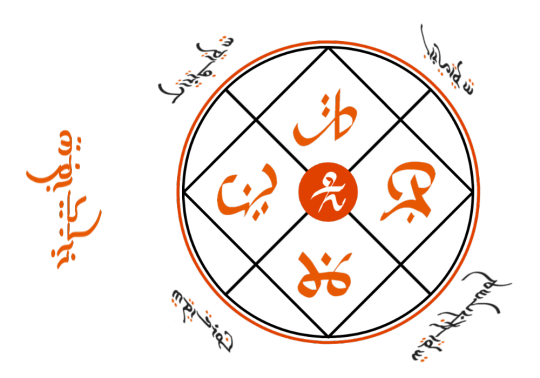
Within the magical sciences (known as Thaumatology in Adia), the Thaumic Sphere is depicted as an abode of dynamic power and unfettered energy, and is one half of the cosmic duality along with the “physical plane” (the Temporal sphere), which is identified with rigidity and coherence. These two planes are extremely close, but due to both existing on different planes of existence cannot directly influence each other. Current cosmological theory suggest that the Thaumic sphere is more of a circulating phenomenon, flowing around specific conduits that fuels life and sapience to its Temporal counterpart. Various points throughout Adia are considered hotspots or nexi of Thaumic activity, and thus anyone with an affinity to it (being anyone with a soul) can conduct or influence it naturally. Naturally, Thaumatological study and conduction of these hotspots have been common throughout history, especially among religious institutions such as the Amatorian Churches.
Thaumic energies influence humans similar to how radiation works. Most of the time, every living creature is influenced by Thaumic energies (having consciousnesses/souls, which are coherent manifestations of Thaumic energy). Depending on the conditions of the energy and the exposed, Thaumic energies can improve, deteriorate or transform a person’s physical and mental state. Prolonged exposure could lead to further irreversible effects, thus making it a common weapon of mass destruction. Such exposure is also the reason for the further dispersion of biological humans to different species.
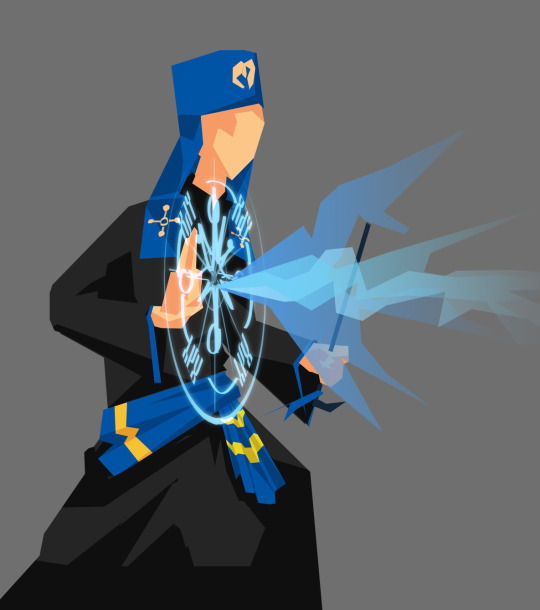
The Thaumatological field, compared to the physical sciences, have fewer and more concise branches of thought, and are commonly divided into two modalities: the religious and the scientific. The religious modality is called Divination, in which Thaumic essences are studied and interpreted within the lens of religious cosmologies. The scientific modality, Metaphysics, looks at such from a neutral and entirely empirical view. The divide between Divination and Metaphysics have become a deep factor in world politics, where Divination has been the ground of more conservative entities and Metaphysics the field of the more liberal and forward-looking “Conditary world”.
imagenotes [1] a diagram of an istanic thaumic seal. [2] a foriscian divinator casting a spell.
2 notes
·
View notes
Photo
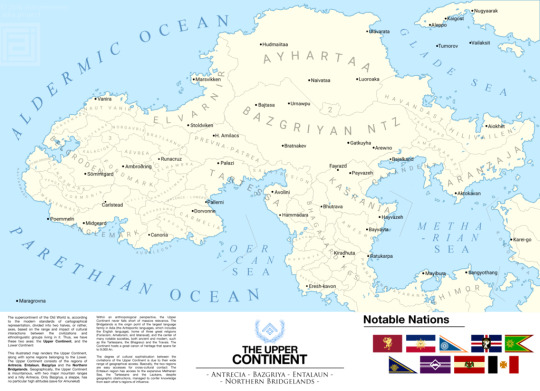
[adia01] Map of the Upper Continent
This is the biggest map I have posted yet.
6 notes
·
View notes
Photo
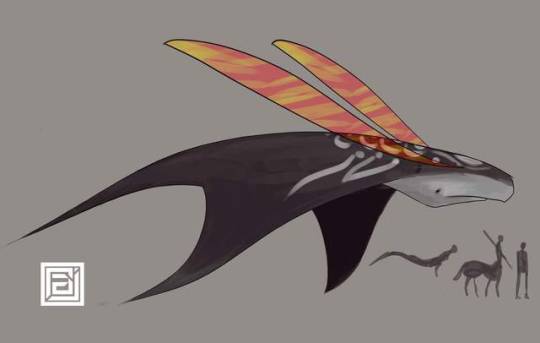
Creature Notes | The Soulwhale
The incorrectly-named Soulwhale (manta thaumicis | kalanvad buzahti) is a peculiar creature. The largest specimen in the Mobulidae family, it is also hypothesized to be the largest marine animal in the world. Compared to the tropical and wide-reaching manta bilostris, the m. thaumicis mostly confines themselves over the northern hemisphere, migrating around the northern polar circle and nesting in the warmer Glade Sea.
One of the defining characteristics of the m. thaumicis is its head. Compared to the other Mantas, the Soulwhale has a more defined skull and has a unique set of membranes that serve as emotional signallers, antennae and (confirmed since 2103 NÆ.) conduits for thaumic energy. This thaumic affinity has led many biologists and zoologists to believe that it is what led them to diverge from the main Manta line. So far, only the Soulwhale is known to conduct these energies other than the sentient races. Another thing to note is their head and fin markings, seemingly artificial pattern which differs from Soulwhale to Soulwhale in a manner not unlike fingerprints. A recent research by a joint team of biologists and metaphysicists from the United Northlands and Kontinovad have discovered—from fieldwork with a herd of Soulwhales—that these Soulwhales are much larger than previously expected, the largest speciment’s fins spanning about 20m in whole.
The Soulwhale in local folklore is a revered character. The Halgaki peoples believe that the Soulwhales are divine creatures that give the people bounty of food and beauty of peace. The Istanic Entalaunis believes similarly, the Soulwhale being oceanic messengers of Avahat.
5 notes
·
View notes
